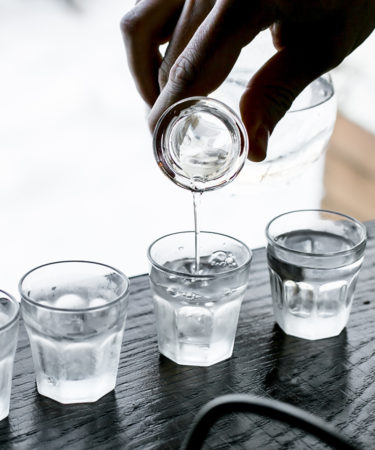
It’s easy to assume you know enough about vodka. The spirit is fairly straightforward: colorless, lower in flavor (if not always quite flavorless), high-test and mixer-friendly. Except that’s like vodka 101. That’s freshman year college vodka (so to speak), and if we’re interested in our distilled beverages, it’s time we get to grad school level.
What’s missing from our Moscow Mule Days and Vodka Cranberry-laced nights is a deeper understanding of one of the most iconic, unsubtle, misunderstood spirits out there. A spirit we abuse—figuratively speaking—with instant recourse to mixers and shots, a spirit we take too often without food, a spirit we for some reasons decided to overlay with a veritable rainbow of candyshop flavorings. There’s a lot more to vodka—and there’s been a lot more to vodka for over a millennium. Time to catch up.
The term “vodka” is a lot like the term “whiskey.”
“Vodka” comes from the Slavic word for water, voda. Whiskey comes from the Gaelic uisge beatha, or “water of life.” (Uisge=water.)
Vodka can be made practically anywhere, but it was born in Eastern Europe.
It’s disputed whether vodka was first produced in Russia or Poland—there’s talk of vodka being produced in Russia in the 9th Century, and in Poland in the 8th Century, but these were both likely crude precursors. The first written record in Poland was in the Sandomierz Court Registry in 1405, while Russia didn’t get “vodka” to paper until 1751. Chances are, some form of vodka distillation was going on in both countries for centuries. (Though yes, Russians do love their vodka.)
Vodka was used medicinally. And it still can be.
Like many alcoholic beverages—and like distilling itself—vodka has some claim to medical applications (it was sold as a possible cure for anything from infertility to the plague; that’s a wonder drug). In this day and age, though, it’s proven effective at disinfecting a toothache and preventing poison ivy (meaning you have to hike with vodka; not the best/worst idea?)
Vodka wasn’t always “flavorless.”
Even if distillation likely came to Europe around the 8th Century A.D., obtaining high proof alcohol from a base (wine or beer) was still a bit of a rougher business. Since impurities were more often left behind, producers would mask them with spices and fruits—though as yet no evidence of early whipped cream flavorings.
Vodka that is “flavorless” is flavorless on purpose.
The Coffey or column still system is what we have to thank for most of the mass-produced, flavorless vodka out there. Because a column still can run continuously (it’s also called a “continuous” still), the alcohol keeps moving through the system, being stripped of impurities (yay!) but also congeners that may impart flavor (boo!). And most vodka is distilled a minimum of three times. And charcoal filtered. Yeah…Hence vodka’s reputation for flavorlessness. Though in truth different vodkas can (subtly) display different flavor notes, fragrances, texture, and even sweetness.

The top-selling vodka brand in the world was started by a Russian peasant.
Specifically, Pyotr Smirnov (recognize the name?). Born a serf—meaning an agricultural laborer stuck in the feudal system—Smirnov is the definition of self-made, taking advantage of every lurch forward in the Russian economy to found and expand his vodka—which he named after the French, not the Russian, spelling of his name.
Smirnov was a trailblazing, ingenious guerilla marketer.
Imagine you’re recently freed from the feudal system, you’re producing your own vodka, and you want to get the word out. Oh, and there’s no such thing as a Bluetooth-ed marketing team at the ready. What do you do? If you’re Pyotry Smirnov, you troll the poorest neighborhoods, invite everyone over for a drink, and pay them to ask for the same in local taverns. Boom, rags to riches.
Vodka can be “corrected” after it’s been distilled.
Like Scotch or bourbon, vodka can actually have certain additives to “finish” or “correct” it—things like sugar, glycerin, or citric acid, the major goal being to soften harshness. Don’t worry, though, the levels are being monitored and are pretty low (1,000 ppm for citric acid, e.g.).
Most vodka isn’t made from potatoes.
In fact, vodka wasn’t even originally made from potatoes (potatoes didn’t make it to the Continent until the 16th Century, when Spanish Conquistadores brought them back from Peru). Potatoes have since proven a viable source in vodka production, but all you really need to make vodka is a sugar source (even just sugar). Most modern vodka is grain-based, though some—hey, Puff!—is made from grapes, even milk whey. In theory, the character of the base ingredient can impact the final product, with wheat-based vodka often lighter and something whey or potato based a bit creamier.
You can use vodka to make aftershave.
Though you won’t want to just use straight vodka—things like bay leaves, spices, rum, and, in at least one recipe, Absinthe, can add complexity of fragrance. (Note: once you’ve made the aftershave, do not attempt to drink it. Obviously.)
Drinking vodka cold serves a purpose.
We store vodka in the freezer, but it’s not an accident or just because the counter is cluttered with craft bourbons. Vodka has a lot of heat to it—distilled to a minimum 40% ABV, but often higher—but when taken cold, that heat is tamed (as are any flavors), and a bit more of the viscosity and richness of the spirit comes out.
More “craft” and higher quality vodkas are getting into the game.
Smirnov started his business using the highest quality available ingredients. Despite the “odorless/flavorless” reputation, more vodka producers are going back to high quality ingredients, looking to flesh out the neglected flavor profile and even score some eco-points. Up to you to decide what you like, and what you’d like to pay for. (In a 2005 New York Times taste test, a $13 bottle of Smirnoff beat out higher-price competition.)

Russian toasting etiquette is intricate and confusing.
When you drink vodka in Russia, you don’t just drink vodka. You toast. Then you drink. Then you toast, then you drink again. And the toasts are supposed to come in a very specific order. Back in the day, it was always “To Stalin!” Yeah,!” The spirit, so to speak, of the toasts have since changed, but depending on where you are, whom or what you toast first, second, third, and so on matters. Though kind of a buzz kill, as was the Young Communists’ favorite “To the success of the scheduled tasks likely the “so on” toasts won’t be as well remembered, so folks can get creative.
Vodka is a mixer. Just not the kind you think.
In Russia, vodka is almost always consumed with food. Not Red Bull, not tonic, not a few good friends and a story of heartbreak. It’s taken with food, “zakuski,” or little plates of this and that to go with your drink(ing). It’s kind of like Russian tapas, except here they’re not just keeping you on your feet, they’re also meant to guard your stomach against the fiery onslaught of vodka.
